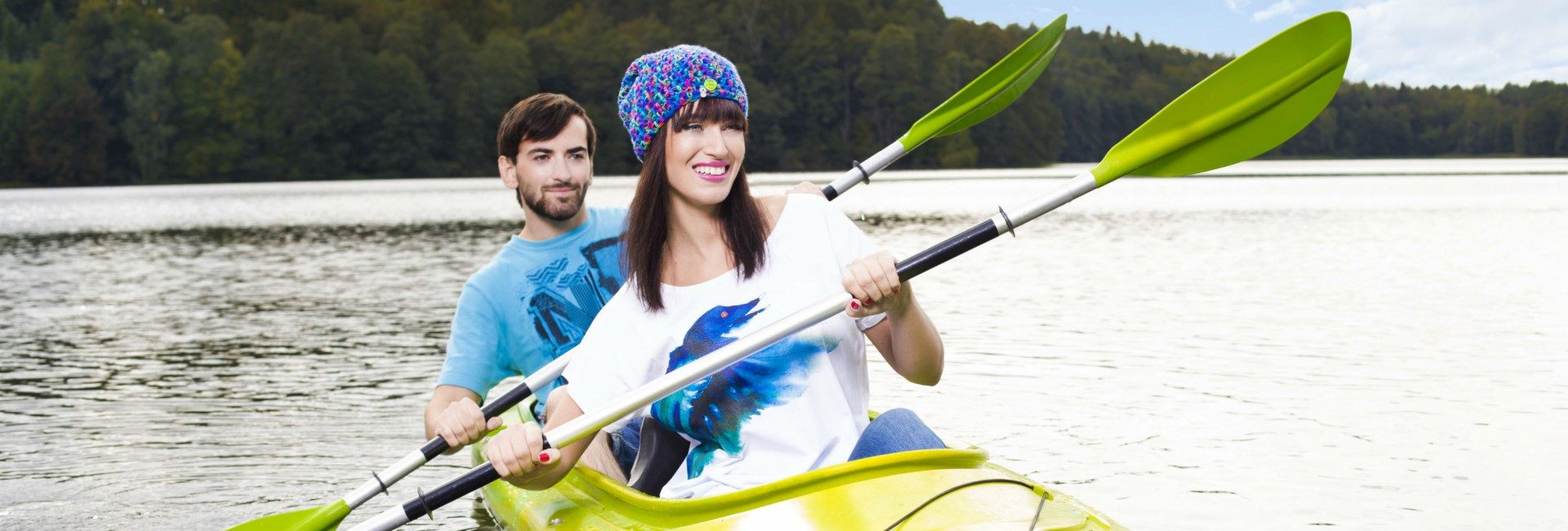Lake Szeląg Mały offers a network of picturesque kayaking trails, leading to the most charming corners of the region, including the heart of the Taborska Forest – one of the most valuable natural areas in this part of Poland.
We organize kayaking trips for both organized groups and individual guests. They are an excellent option for an active holiday combining exercise, relaxation, and closeness to wild nature.
For individuals and groups who want to enrich their adventure with stories and interesting facts about the area, an experienced kayaking guide is available (additional fee required, advance reservation required).
KAYAKING FROM THE HOTEL BEACH
From Lake Szeląg Mały, a canal built in the 19th century leads to the vast waters of Lake Szeląg Wielki – one of the most beautiful lakes in Masuria. Along the trail, you may encounter protected bird species, including the majestic white-tailed eagle, as well as cranes, herons, and grebes. Due to its natural and cultural values, the area is legally protected as the Elbląg Canal Protected Landscape Area.
SZELĄG TRAIL
River trips also take place on the so-called Szeląg Trail between Ostróda and Stare Jabłonki. This is one of the most beautiful sections of the Elbląg Canal. The 18-kilometer route passes through Lake Drwęckie, Lake Pauzeńskie, Lake Szeląg Wielki, and Lake Szeląg Mały. Kayaks pass through the locks twice, in Ostróda and Mała Ruś. The trip can begin in Ostróda or Stare Jabłonki.
ELBLĄG CANAL
The Elbląg Canal, formerly known as the Oberland Canal (Oberland – Upper Poland, Upper Prussia), is the only waterway of its kind in the world. Unique on a global scale are the so-called slipways, which allow ships to pass from one section of the canal to the other on dry land. What's unique is the power of water that powers the entire machinery. There are five slipways – Buczyniec, Kąty, Oleśnica, Jelenie, and Całuny. The distance between the first and last is approximately 10 km, with an elevation difference of almost 100 m. To overcome such a great height between the slipways, the kayak is transported by a rail cart over a so-called "dry ridge." The best place to learn how the slipways operate is Buczyniec (approximately 60 km from the hotel). Here, you can observe ship traffic on the slipway, visit an interesting museum, and go rafting on the canal. In Buczyniec, you'll also see a monument to the builder of this waterway – Georg Jacob Steenke, an architect, construction manager, and inspector all in one. He designed a system of locks and slipways to overcome the differences in water levels between the individual bodies of water. The main section of the canal was opened in 1860. Subsequent stages were completed until the 1880s, creating waterways with a total length of approximately 150 km. They connected Iława (Jeziorak Lake), Stare Jabłonki (Szeląg Mały Lake), Ostróda (Drwęckie Lake), Miłomłyn (canal crossing), and Elbląg (Elbląg River, Vistula Lagoon). Initially, the canal was used for freight transport. Soon, the railway took over, and passenger services were launched. Today, the Elbląg Canal is one of the biggest tourist attractions in the Warmian-Masurian Voivodeship.
DRWĘCA
The closest river offering kayaking is the Drwęca. Guests of the Anders Hotel typically paddle the Idzbark–Ostóda route (approx. 10 km).
MARÓZKA
One of the most beautiful kayaking routes in this area is the Marózka River, a tributary of the Łyna River. The river flows through the forest, under a canopy of trees, and is shallow and crystal clear. On the Marózka River, you can paddle from Swaderki to Kurki.
ŁYNA
You can rafting down the Łyna River while visiting Olsztyn's Old Town. You can start your rafting trip at the Warmian Chapter Castle and end it after about two hours, still within the city limits. The entire trip takes place in the incredibly charming Olsztyn City Forest, one of the largest in Europe.





